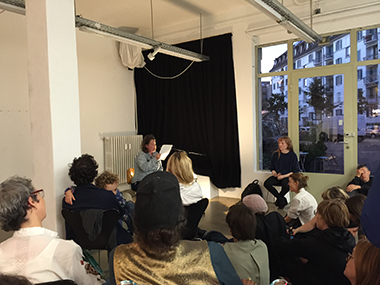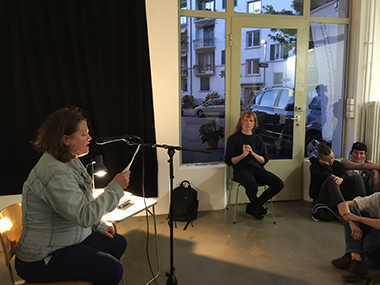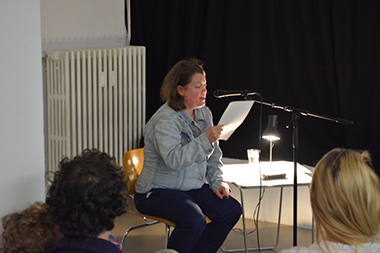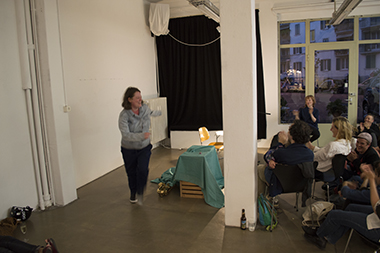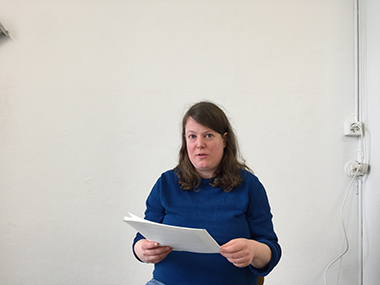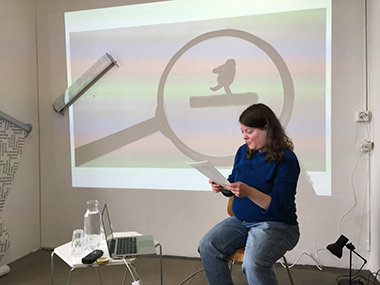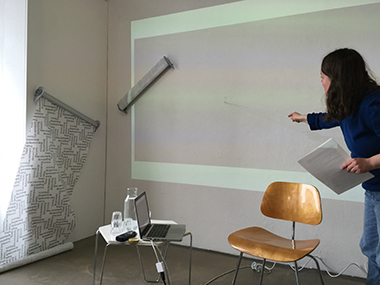Corner College zu Gast im TAUT und im Kunstverein Wagenhalle e.V.,
Innerer Nordbahnhof 1, Tor 4 - 6, 70191 Stuttgart
Mit der freundlichen Unterstützung der Schweizer Kulturstiftung Pro Helvetia und des Bundeskanzleramts Österreich.
End!angered Species
Plantation Memories and Other Troubled Voices
in the Age of the Capitalocene
A group exhibition with works on display by Ulrike Buck, Monica Ursina Jäger, Knowbotiq, Uriel Orlow, Ana Roldán, Katharina Swoboda, Lena Maria Thüring
and performances by Ulrike Buck, Ana Roldán, Katharina Swoboda, Anne Käthi Wehrli
curated by Dimitrina Sevova
a collaboration between Kunstverein Wagenhalle e.V., Stuttgart, and Corner College, Zurich.
at Kunstverein Wagenhalle e.V. / TAUT
Innerer Nordbahnhof 1, Tor 4 - 6, 70191 Stuttgart
Opening Friday, 28 October 2016 at 18:30 h
20:00 h Performance Banana as Tourist by Ana Roldán
20:45 h Lecture performance On the Grouping of Penguins by Katharina Swoboda
21:30 h A radio show as a carrier bag into natural science Bakterien Tragnetz Radio by Anne Käthi Wehrli
Finissage Saturday, 26 November 2016 at 18:30 h
19:00h Lecture performance Grete und das Fäustchen by Ulrike Buck (canceled due to illness)
Friday, 28 October 2016 - Saturday, 26 November 2016
Works in the exhibition, and performances
Ulrike Buck
Grete und das Fäustchen
Performance lecture, 2016.
Eine bebilderte Vortragsperformance folgt dem schizoiden Naturverhältnis des Menschen mittels persönlicher Assoziationsketten durch die verschütteten Mindsets diverser Epochen.
I think I do not understand very much, aber ich begreife.
Glasierte Keramik, I-phone video-collage, Spiegel
Paris, Berlin, Südtirol, Stuttgart 2015-16
Zur Ausstellung Endangered Species präsentiere ich eine Collage, deren Teile an vielen verschiedenen Orten entstanden, die Installation schliesslich hier im TAUT.
Ich verstehe diese Keramikarbeiten genauso wie die Videocollagen als field recordings. Formen resultieren aus Assoziationsketten, die sich zwischen innerer und äusserer Umwelt zusammensetzen. Werkzeuge, Verbindungsstücke und Gefässe die mit undefinierten multiplen Funktionen assoziiert werden können, sind Artefakte einer persönlichen Archäologie und tragen doch archetypische Züge. Keramiken entstanden teils in Paris, teils in Berlin, das Video auf meinem I-phone letzte Woche auf dem Salten in Südtirol.
Ich denke man kann die Installation nicht verstehen, aber begreifen.
I think I do not understand very much, aber ich begreife.
glazed ceramics, iphone-video collage, found mirror and projector
Paris, Berlin, Italian Alps, Stuttgart 2015-16
I made this collage here in the TAUT from debris that was in my car when I arrived in Stuttgart now, from a road trip from Berlin to Vienna and South Tirol, where I took part in other group shows. For me both the ceramics and the video are something like field recordings of the internal and external worlds that I encounter on my journeys through time and space. Tools, vessels and connection elements with undefined and undefinite functions are artefacts of my personal archeology. Ceramics were made in Paris and Berlin, the video last week on my i-phone in the alps.
There is nothing to understand here, but to grasp.
Monica Ursina Jäger
Topographies
Installation, 2014.
For several years Monica Ursina Jäger has been drawing built and natural landscapes inspired by Modernist-style architecture. Her precise works, using media including ink and pigment transfers, combine hope and downfall: on one hand designers’ aspirations, and fantasies, for the future; on the other the dystopia of failure. In creating these works Jäger has assembled a huge stock of images of buildings and environments, both her own photographs and images found in print and online, including rendered as well as completed constructions. ‘Topographies’ consists of one, extremely long image created from hundreds of collaged images from this working archive.
The viewers can follow the nearly 12 meter long collage as if with a filmic tracking shot, or they can examine it in a less linear fashion. Whichever way they view it, the route is through man-made, forested and barren landscapes, some sites iconic, some prototypical, with an emphasis on the architectural ambitions of the 1960s. Our viewpoint moves from afar, to close up, the scenes largely in black and white with accents of colour that emphasise the chill of the dystopian environments. With few signs of human life, Jäger captures the temporality of the most solid concrete and steel buildings. Like the fictional visions of Cormac McCarthy, this could be a past we have escaped or a future we would like to avoid.



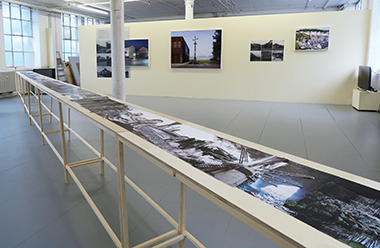

cold frame – vertical garden
Chlorophyllin on concrete boards, 260 × 625 cm, 2016.
The multi-part painting is executed with differing concentrations of chlorophyll (Blattgrün). This light- sensitive natural pigment will slowly fade over the course of the exhibition.
The geometrical shapes in cold frame – vertical garden 2016 are taken from a ‘Tensegrity’ structure.
Tensegrity (portmanteau of tension and integrity) has been discovered by artist Kenneth Snelson and Richard Buckminster Fuller during the summer institute at Black Mountain College in 1948. Giving the impression of a cluster of struts floating in the air, tensegrity structures are composed by a set of compression components suspended within a continuous tension network. This results in a structure where ‘compression elements become small islands in a sea of tension.’ (Buckminster Fuller 1961) While Snelson examined this principle in his sculptures, Buckminster Fuller and David Georges Emmerich explored its applications to architecture and engineering. Thirty years later, Donald E. Ingber, professor of pathology at Harvard Medical School, discovered tensegrity structures in biology (carbon atoms, water molecules, proteins, viruses and other living creatures). Tensegrity proved to be a universal principle corresponding to a particular field of forces in a stable equilibrium under a precise distribution of elements. Recently it has been proposed that not only the human skeleton but also the central nervous system function as tensegrity structures, where some elements are continuously pulling and others are discontinuously pushing.
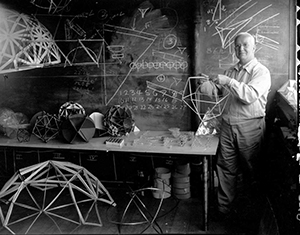
Buckminster Fuller at Black Mountain College, 1948.

Students at Black Mountain College with Tensegrity dome.
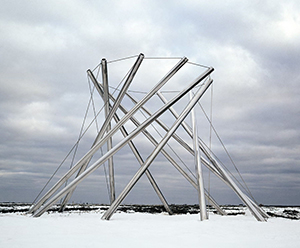
Sculpture by Kenneth Snelson based on Tensegrity.
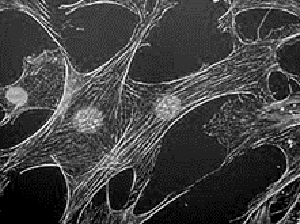
Tensegrity in human fascia.
Since the advent of the Internet, with its explosive cross-pollination of knowledge, ideas and discoveries, tensegrity has become a key principle across many disciplines. Research is being conducted in Biotensegrity to examine the architecture of cells and viruses to invent revolutionary treatment. New ways of geometric, responsive structures are being developed in design and engineering and anatomical research has led to new ways of understanding the structure of the human body.
This installation takes tensegrity as a starting point to examine whether ‘tensional integrity’ is something other than just a spatial structure of struts and strings. Where do we recognise forms of push and pull strategies, tension-pressure relationships and stability-flexibility structures within our fields of research and interests? In the face of the current political climate with social shifts, systemic ruptures and ecological crisis, notions around fragility, tension, dynamic relations and resilience might become more and more important.
– Monica Ursina Jäger
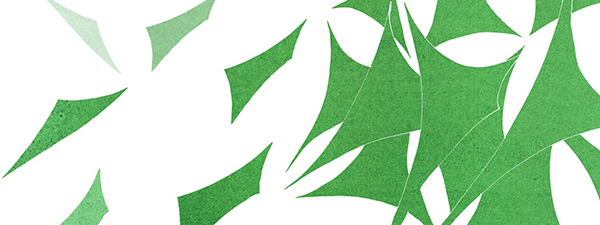
Monica Ursina Jäger, cold frame – vertical garden, 2016.
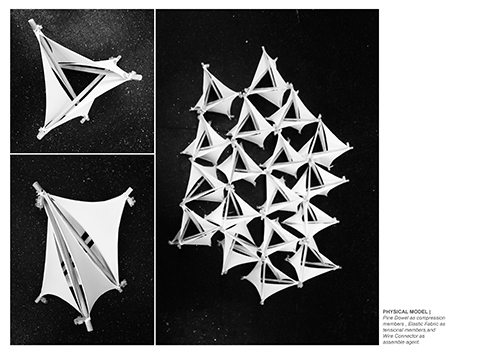
Knowbotiq (Yvonne Wilhelm, Christian Huebler)
golden aphrodisiac - quantum ecologies of bodies
2016
mit Unterstützung des ifcar/ZHdK; konzeptuelle Mitarbeit: Nina Bandi; Sound: Fred Hystère und knowbotiq; Tanz: Teresa Vitucci.
Das installative Setting ist eine Auskoppelung aus dem grösserem Projekt: Swiss Psychotropic Gold 2016, welches die Rolle des Rohstoff Gold in den ästhetischen und affektiven Ökonomien am Beispiel der Schweiz verhandelt. Das Projekt befragt das Verhältnis von Materialität und Form, welches im Falle dieses Edelmetalls besonders eindrücklich ist. Gold durchläuft, einmal gefördert, einen sich wiederholenden Zyklus von Verarbeitung und Wiedereinschmelzung und ist so für jegliche ökonomische, psychologische und politische Reinigungs- und Anonymisierungsprozesse hervorragend geeignet. Das hochglänzende, weich schützende, psychoaktive Metall quantifiziert und molekularisiert die Narrative über Gewalt, Ausbeutung, Bereicherung, Versprechen und Verschuldung, die die Förderung, den Handel und den Gebrauch des Edelmetalls massiv begleiten. Diese biopolitische Komponenten des „Rohstoffwechsels“ sind für die Schweiz besonders dringlich, da 70% des weltweit geförderten und gehandelten Goldes hier raffiniert werden; begleitet und angetrieben von calvinistischen Vorstellungen, dass der Besitz und die Distribution von Gold als God’s Money den Menschen zu ökonomischen und philanthropischen Höchstleistungen motiviert.
Gold ist nicht seinen „klassischen“ Formen wie Nuggets, Goldbarren und Schmuck verhaftet. Im Gegenteil, es ist stark dispersiv, zerstreut sich an und in allen organischen Lebensformen, in Finanzderivaten, an Platinen von Kommunikationstechnologien, als inversive Mikro- und Nano-implantate oder als Tracer in Bildtechnologien. Es bildet vegetative - geologische - technische - pornotropische - somatopsychisches Gefüge, verschränkt in molaren und molekularen Ökologien. Es ist potentiell überall, nicht vergänglich und verfügt über keine bestimmte Zeitlichkeit. Gold als „totes“ Edelmetall dynamisiert als ästhetische und libidinöse Droge affektierbare Körperlichkeiten. Es erfüllt projektive und imaginative Begehren nach Unsterblichkeit, Jugendlichkeit, (sittlicher) Reinheit, Liebe oder (nationaler) Sicherheit.
knowbotiq hat Stoffmuster entwickelt, die diese komplexe Narrationen aufnehmen. Unbearbeitet, als Meterware präsentiert, sind sie “commemorative fabrics“ des Goldes. Sie sind Textilien, die, einer visuellen ornamentalen Rhetorik folgend, die oben beschriebenen multiorganischen, quantifizierten und psychotropen Körperlichkeiten fabulieren. Die Muster nehmen Zustände und Möglichkeiten verschränkender Volumen vorweg, mit denen sie, begleitet durch Schnitte, Drapierungen, Faltungen und Nähte, die durch Gold quantifizierten Körper markieren und kommentieren könnten. Den Stoffbahnen werden über zwei Monitore Aufzeichnungen formloser Körperkonstitutionen im Raum angefügt, die Erwartungshaltungen von ästhetischer Dynamik, kontrolliertem Bewegungswissen und emphatischer Vereinnahmung unterlaufen.
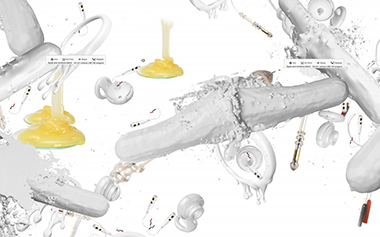
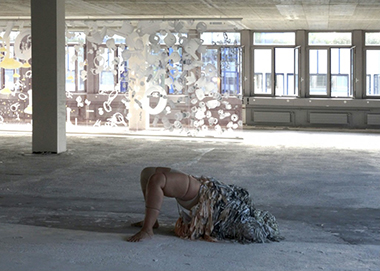
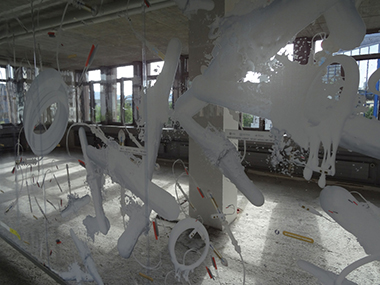
Uriel Orlow
The Fairest Heritage
2016. HD video (looped), color, silent, 4′ 18″.
In 1963, on the occasion of the 50th anniversary of the founding of Kirstenbosch, the national botanical garden of South Africa in Cape Town, a series of films were commissioned to document the jubilee celebrations with their ‘national’ dances, pantomimes that revisit the colonial conquest, the visit of international botanists and the history of the botanical garden itself. The films’ protagonists of scientists, visitors etc. are all white – the only times we see Africans they are engaged in menial labour.
The films have not been seen since 1963 and were found by the artist in tins in the cellar of the library of the botanical garden. The Fairest Heritage is an attempt to watch these films today and engage with their attendant politics of representation. An actor, Lindiwe Matshikiza, inhabits the found footage and interacts with it, putting herself and her body in the picture and deconstructing the botanical nationalism and the flower-diplomacy of apartheid era South Africa.
– Uriel Orlow
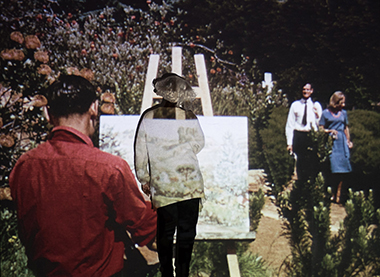
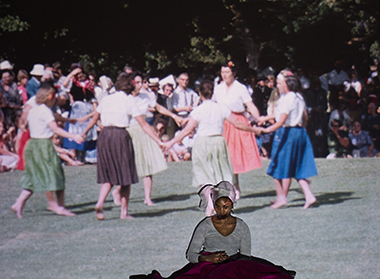
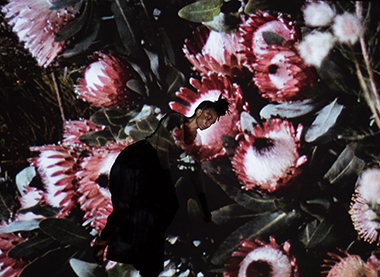
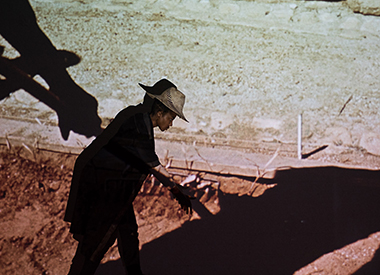
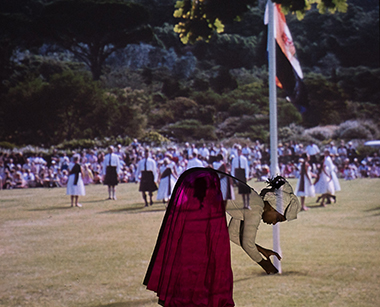
Ana Roldán
Withering Paradisiaca
Table, glass table top, banana flower, 65 × 70 × 100 cm (table), flower size variable, 2014.
The relationship between civilisation and nature, even in its most domesticated form, is a theme in Withering Paradisiaca. In this contemplative work, nature, or rather what is apparently natural, becomes a set of socially multifaceted signs. On the one hand, there is a process which in itself is natural: the slow wiling of a banana blossom that invites us, like a Baroque memento mori still life, to think about transience.
- Elisabeth Gerber, annex 14
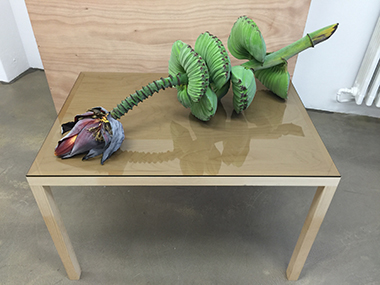

Installation views in the exhibition New Buenos Aires at Corner College, 27.05.-26.06.2016.
Banana as Tourist
Performance, 2016
Inspired on “Nature” by Ralph Waldo Emerson
“Nature is not fixed but fluid; to a pure spirit, nature is everything”
Ralph Waldo Emerson
In the tropics reigns perpetual youth. Within the domesticated plantations of goods, the work and value empires, a perennial festival is dressed, and the guest can not imagine how he or she should get tired of it in a thousand years. In the tropics we return to reason and faith. There I feel that nothing can befall me in life, which nature cannot repair. Standing on the bare ground, all mean egotism vanishes. I become a transparent eye-ball; I am nothing; I see all; the currents of the Universal Being circulate through me; I am part, I am a particle of Nature. I am the lover of uncontained and immortal beauty.
In the boiling wilderness and especially in the curved lines of odours bananas, one beholds somewhat as beautiful as one’s own nature. As bones, as bananas. The greatest delight which the tropics minister is the suggestion of an occult relation between people and the vegetable. Yet it is certain that the power to produce this delight, does not reside in nature, but in human, or in a harmony of both. The heat of man or woman labouring under calamity, illuminate the Nature wearing all the colours.
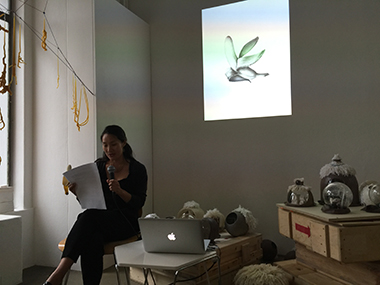
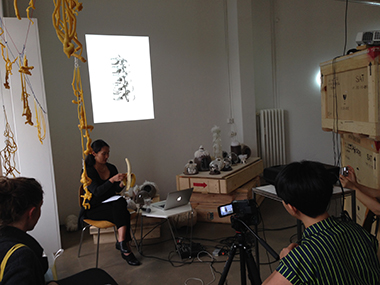
Performance Banana as Tourist by Ana Roldán, with the voice of Jen Prosperi, at the finissage of the exhibition New Buenos Aires at Corner College, 26.06.2016.
Katharina Swoboda
Penguin Pool
2015. video / hd / loop (3,20 ¬min) / colour/ sound
Sound – Sara Pinheiro / Katharina Swoboda
Designed by Russian Emgiré Berthold Lubetkin in 1934, the ”Penguin Pool“ in London Zoo is one of the most important modernist buildings in Great Britain. In 2004, the penguins were removed because of concerns regarding animal welfare. Since then, the iconic architecture has been ”empty“, animated only by water fountains. In the video, this emptiness is forced by masking out the zoo environment. Without the visual context of the surrounding, the ”penguin pool“ becomes an utopian model again.
Das Video zeigt den «Penguin Pool», eine modernistische Zooarchitektur die sich im Londoner Zoo befindet. Das Video entstand aus meiner Beschäftigung mit zoologischen Gärten und Architekturen, die für Tiere gebaut wurden, insbesondere mit den Architekturgruppe «Tecton». Aufgrund der heutigen Tierschutzbestimmun-gen und Praxen beherbergen viele der damals konstruierten Bauten der Gruppe nicht mehr die ursprünglich für sie angedachten Tiere, der Penguin Pool steht beispielsweise komplett leer. Die Besucher im Zoo sind auf der Suche nach den Pinguinen, die wenigsten sehen die Architektur. «Where are the animals?» «There are no animals!» Die Besucher wurden aus dem Bild ausmaskiert, es bleibt die heute utopisch anmutende Architektur.
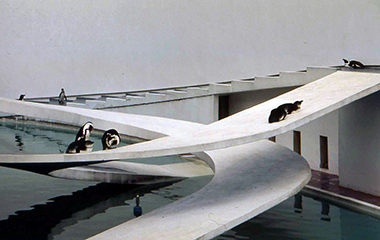
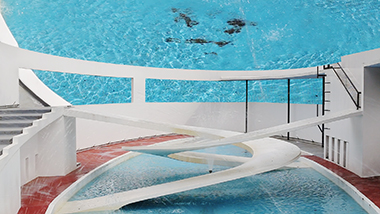
Penguin Pool (2015), video stills.
Pelzvogelkasten
2015. video / hd / 5 min / colour / sound
Camera – Leopold Leskovar
Performance – Annika Scharm
Sound – Sara pinheiro, Katharina Swoboda
Pelzvogelkasten [translated “fur-bird-box”] is originally an object created by Ursula Schultze-Bluhm, which she made in the iconic year of 1968. The object is part of the collection of mumok (museum für moderne kunst der stiftung ludwig wien) in Vienna. The «Pelzvogelkasten» consists of what it is named after: a sewing box, which is covered with fur and feathers with a dead pheasant on the top. The single boxes are filled with materials such as beads, maize-cobs and little puppets. The video deals with the process of video-making itself in relation to the „Kasten“.
Der «Pelzvogelkasten» ist ein Objekt der Künstlerin URSULA (Ursula Schultze-Bluhm) aus dem Jahr 1968. Es besteht aus den Materialien, auf die der Titel bereits verweist: ein Nähkästchen, welches von Pelz und Federn bedeckt ist. Darauf angebracht ist ein toter Fasan. Die einzelnen Fächer des Nähkastens sind mit unterschiedlichen Materialien gefüllt: Perlen, Maiskörner und kleine Puppenfiguren. Das Video beschäftigt sich mit dem Prozess der eigenen Videoproduktion im Verhältnis zur Struktur und Bauweise des «Kastens».
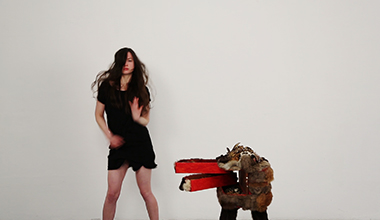
Pelzvogelkasten (2014), video still.
On the Grouping of Penguins
Lecture performance, 10 min
The lecture performances focuses on the history of the “Penguin Pool” in London and the surprising relationship between early modernist architecture and animals in Great Britain. Today, the “Penguin Pool” is empty and without animals – a void in the zoological garden that offers a variety of possibility to be explored during the performance.
Die Lecture-Performance beleuchtet die Geschichte des “Penguin Pools” in London und die überraschende Beziehung zwischen frühmodernistischer Architekture und Tieren in Großbritannien in den 1930er Jahren. Heute steht der „Penguin Pool“ leer, es werden keine Tiere mehr darin gehalten. Eine Leerstelle im Zoologischen Garten, die im Laufe der Perfomance Anlass zu unterschiedlichen Spekulationen gibt.
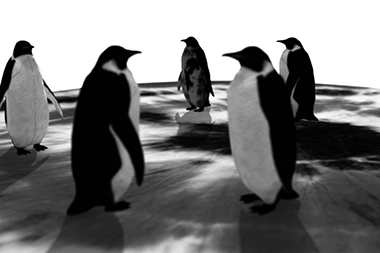
Grouping of penguins, screen shot from 3d modeling software, 2015.
Gruppieren von Pinguinen. Screenshot von 3D Modellierungsprogramm, 2015.
Lena Maria Thüring
Gardien de la paix (GPX)
2011. HD Video, single channel, 16:9, colour, sound, 18 min 47 sec, French, German subtitles
Den jungen französischen Polizisten in “Gardien de la paix (GPX)” (2011) hat die Künstlerin beim Besuch in der Cité nationale de l’historie de l’immigration (vormals Musée de la France d’Outre-mer und Musée des Arts d’Afrique et d’Océanie) in Paris kennengelernt. Seit Eröffnung des Gebäudes befindet sich im Untergeschoss ein Aquarium, bestückt mit Fischen aus allen ehemaligen französischen Kolonien, welches der Polizist in seinen freien Minuten regelmässig besucht und das sich als sein persönlicher Defiant Garden präsentiert. Der Protagonist, den wir nicht sehen, sondern nur hören, erzählt von der Schwierigkeit, zwischen seinem Privatleben und seiner öffentlichen Funktion eine Balance zu finden. Auch er muss im Kollektiv der durch die Uniform verkörperten Staatlichkeit funktionieren. Auch bei ihm erfahren wir nach und nach eine persönliche Geschichte, die von der Herkunft seiner Eltern aus Guadeloupe erzählt und vom Polizistenalltag, in welchem er sich oft als “verbaler Abfalleimer der Welt” vorkommt. Vor dem Bild der Fische im Aquarium und mit seiner Wortwahl, die immer wieder auf Vergleiche mit der Tierwelt rekurriert, wirkt sein Wunsch nach Harmonie und Gewaltfreiheit direkt auf uns ein, und wir merken erst nach und nach, dass sich unser Bild eines Polizisten verändert hat.
Sabine Schaschl, Kunsthaus Baselland, Schweiz
The artist met the young French policeman in “Gardien de la paix (GPX)” (2011) during a visit to the Cité nationale de l’historie de l’immigration (previously Musée de la France d’Outre-mer and Musée des Arts d’Afrique et d’Océanie) in Paris. Ever since the building’s opening its basement has housed an aquarium containing fish from all the former French colonies. The policeman regularly visits this aquarium in his free time, and it turns out to be his personal defiant garden. The protagonist, whom we don’t see, only hear, describes his difficulty of finding a balance between his private life and his public function. He also has to function in the collective of the state which is embodied by his uniform. With him as with the others, we gradually hear his own story which tells of his parents’ origins in Guadeloupe and everyday life as a policeman, in which he often feels as if he had to take in all the world’s hot air. With the fish in the aquarium as backdrop and his choice of words which time and again refer back to the world of animals, his wish for harmony and non-violence has a direct impact on us, and we only gradually realise that our image of a typical policeman has changed.
Sabine Schaschl, Kunsthaus Baselland, Switzerland
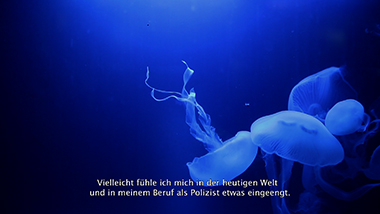
Anne Käthi Wehrli
Bakterien Tragnetz Radio
A radio show as a carrier bag into natural science, 2016.
Artist Bios
Ulrike Buck
Ulrike Buck works in the expanded field of sculpture. Her practice is informed by an anthropological interest in magic, in marginalized technologies and knowledge that aim to set the human body into direct communication with material matter. She has conducted spiritual séances between continents over skype, planted a vertically hanging magical garden to entertain an art institution and found herself channeling Robert Smithson by revisiting Hotel Palenque and later lecturing about dearchitecturalisation in the jungle. Sculptures and objects in Buck’s oeuvre show formal similarities to new age architecture and interiors but oscillate between non-function and unknown function. Sculpture may ultimately be experienced as a vehicle or tool to celebrate the unity of body and mind.
Buck was born 1983 on the Swabian highland, Southern Germany. She studied mainly in Stuttgart and is now based in Berlin.
http://www.ulrikebuck.de/
Monica Ursina Jäger
* 1974, Thalwil, Switzerland. Lives and works in London and Zurich.
Monica Ursina Jäger is a Swiss artist and lecturer living in London and Zurich. Her multidisciplinary practice engages with spatial experiences both within the natural and constructed environment. Jäger makes drawings, sculptures and installation works through which she acknowledges the multifaceted nature of the spatial experience and the rich history of its representation. Her cognitive-map-like use of imagery, alongside linear architectural structures, gives one a sense of both everyday and fantastical moments of overlap between the many signifiers by which we ‘read’ physical environments and recall our experiences of them. Recent works address the uncertainties of geopolitics related to natural resources and man-made construction. Interdisciplinary projects include urban planning, green infrastructures and narrative environments in public spaces.
Jäger studied in Singapore and London and gained her MA at Goldsmiths College. She has exhibited widely nationally and internationally, e.g., Kunsthalle Düsseldorf, Kunstmuseum Thun, Haus für Kunst Uri, Galeria Pilar Sao Paulo, Kunstmuseum Chur, Sammlung Essl Klosterneuburg/Wien, Haus Konstruktiv Zurich, Kunsthalle Osnabrück, Kunstverein Pforzheim. Winner of the Swiss Art Award 2007. Monica Ursina Jäger is a lecturer at University of Applied Sciences Zurich ZHAW at the Institute of Natural Resource Sciences IUNR.
http://www.muj.ch
Knowbotiq (Yvonne Wilhelm, Christian Huebler)
has been experimenting with forms and medialities of knowledge, postdigital agency and epistemic disobedience.
knowbotiq (formerly: knowbotic research/together with Alexander Tuchaček) has participated in the 48th Venice Biennale (1999), Seoul Biennale (2002), Hongkong Shenzen Biennale (2007), Biennale Rotterdam (2009), Moscow Biennale (2011), exhibited in Museum of Contemporary Art, Helsinki, (1994), Hamburger Kunstverein (1995), Henie Onstad Kunstsenter Oslo (1996), Museum Ludwig Köln (2000), New Museum New York (2002), Witte de With Rotterdam and MOCA Taipeh (2004), Kunsthalle St. Gallen (2005), Wilhelm Lehmbruck Museum and Skuc Gallery Ljubljana (2006), NAMOC Beijing (2008), Aarhus Kunstmuseum (2009) and has received major awards including: the Swiss Art Award (2012), the Claasen Prize for Media Art and Photography, Cologne; the international ZKM Media-art award; August Seeling-Award of Wilhelm Lehmbruck Museum and the Prix Arts Electronica.
knowbotiq has a professorship at the University of the Arts Zurich.
http://knowbotiq.net
Uriel Orlow
Uriel Orlow is a visual artist and sometime writer working in London and Zurich.
Orlow’s practice is research-based, process-oriented and multi-disciplinary including film, photography, drawing and sound. He is known for single screen film works, lecture performances and modular, multi-media installations that focus on specific locations and micro-histories and bring different image-regimes and narrative modes into correspondence. His work is concerned with spatial manifestations of memory, blind spots of representation and forms of haunting.
Orlow has exhibited in museums, galleries, film festivals and biennials internationally including the 54th Venice Biennale, Manifesta 9, Mercosul Biennale, Tate Britain and Whitechapel Gallery London, Palais de Tokyo Paris, CIC Cairo and Jewish Museum New York. Last year he had a major solo show at Castello di Rivoli in Turin and in autumn 2016 he presents a new body of work at The Showroom, London. Uriel is also a visiting professor at the Royal College of Art in London, an associate professor at Westminster University London and a visiting artist at the University of the Arts Zurich.
http://www.urielorlow.net/
Ana Roldán
My work is inspired by cultural phenomena: Historical events, philosophical ideas, language, systems, reflections on aesthetics; theoretical concepts in general. I am interested on how the spectators can be stimulated in a physical way as well as in an intellectual way through the opposition or displacement of the mentioned systems.
Ana Roldán, Mexico city, 1977. Lives and works in Zurich.
Her work has been individually exhibited at Badischer Kunstverein, Karlsruhe (2011), Ellen de Brunije Proyects, Amsterdam (2010), Kunsthalle Arbon (2009). As well as in collective shows at Casa del Lago, Mexico City (2012), Museo Tamayo, Mexico City (2012), La Central, Bogota (2012), Kunsthalle Zurich (2012), Kunsthalle Bern (2009).
http://www.anaroldan.ch/
Katharina Swoboda
Katharina Swoboda, born 1984, Graz, AT. Lives and works between Hamburg, Vienna and Graz.
Katharina’s work is predominantly video-based but she works in photography, installation art and performance art as well. She graduated from the Academy of Fine Arts in Vienna, and has been a PhD student at the transdiciplinary doctorate programme at University of Fine Arts of Hamburg since 2014. Katharina’s videos have been internationally shown in selected venues in Vienna, Houston, Panamá, London, Budapest and Hamburg. She has received several scholarships, e.g from the Austrian Federal Ministry for Arts and Culture, and has participated in the KAMOV City of Rijeka residency in Croatia and the Nida Art Colony in Lithuania. She is member of the Golden Pixel Cooperative in Vienna.
http://katharinaswoboda.net/
Lena Maria Thüring
* 1974, born in Thalwil Switzerland
Lena Maria Thüring’s work explores individual stories in a reflection on social systems and their underlying constructions using various media, such as photography, performance, video or installation.
The interview forms both the starting point and the staging ground for much of Lena Maria Thüring’s recent filmic work. Her films and videos explore how individuals forge their identities and shield their memories in the shadow of larger group dynamics and the socio-political systems in which they are cast, using personal narrative — its gaps and elisions, its specificity and opacity — to reveal how meaning is constructed, projected, protected, and perhaps deconstructed. Detaching the spoken narrative from the subjects’ bodies and even their voices, Thüring creates a fissure between seeing and hearing, identity and biography. Within this space we can consider the nature of memory, the power of words, and the significance of all that remains unsaid.
Born in Basel 1981, lives and works in Zurich.
Thüring’s work had been shown in solo exhibitions at the Kunsthaus Baselland (2012) and the Museum für Gegenwartskunst Basel 2013 and in groupshows and screenings at the Kunstmuseum Bern, Kunsthalle Basel, Haus der Kulturen Berlin, the Reina Sofia National Museum Madrid in Spain and the Palais de Tokyo in Paris. She received several awards including Swiss Art Award (2008), Kiefer Hablitzel Foundation Award (2011), Grant from Zurich City (2012), Manorkunstpreis Basel (2013) and two artist residencies in Paris (2009) and New York (2010).
Thüring is a member of the Fachausschuss Audiovision und Multimedia BS / BL.
http://www.lenamariathuering.ch/
Anne Käthi Wehrli
Anne Käthi Wehrli ist Künstlerin in den Bereichen Performance, Arbeiten mit Text, Audio und Zeichnungen, Herausgeberin von Fanzines und Radiomacherin.

































